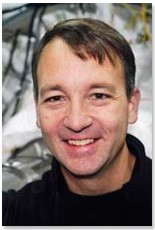Recent Colloquium
Colloquium # 251
Chasing Fast Dynamos in the Plasma Lab and Other Pursuits
by Prof. Cary B Forest, Department of Physics, University of Wisconsin, Madison
Monday, June 1st 3:30 PM, Seminar Hall

Abstract
Two seemingly unrelated questions in plasma astrophysics, namely the origin of astrophysical magnetic fields and the high rate of accretion observed need to explain x-ray luminosity of black holes or star formation rates in protostellar disks may now, for the first time, be addressable by laboratory experiments. Studying such conditions in the lab require hot and confined, fast flow YET unmagnetized plasmas. I will describe two plasma experiments, one in a cylindrical Couette geometry and one in spherical Von Karman geometry that are now poised to create plasma dynamos and also observe the Magneto-rotational instability. The experiments use multi-dipole plasma buckets to contain a 20 eV plasmas that can be stirred at speeds up to 10 km/s. These conditions appear well suited for observing these processed in the lab.
About the speaker
Prof. Cary B Forest received a Bachelor of Science degree from the University of Wisconsin in 1982. He received a Magnetic Fusion Energy Science Fellowship from the DoE to attend graduate school at Princeton University where he received a Ph.D. in 1992 in the Astrophysical Sciences department. His thesis, supervised by Dr. Masayuki Ono at the Princeton Plasma Physics Laboratory, received the Simon Ramo Award for Outstanding Doctoral Thesis Research in Plasma Physics from the APS. In the course of his thesis work he invented and demonstrated a non-inductive method of tokamak formation based upon the bootstrap current. After graduate school he spent 5 years working at General Atomics as a Scientist where his work focused on studies of plasma resistivity, non-inductive current drive, rf heating of plasmas and MHD instabilities in tokamak plasmas. The analysis technique Forest developed during this time for measuring the non-inductive currents driven in tokamaks has since been implemented in most of the world's large tokamaks and played a central role in validating the heating and current drive models being used to predict their behavior on Iter. At the UW, Forest has received the Romnes Fellowship, the Vilas Associate Award and the Kellett Mid Career Award. Nationally, he is the recipient of the Alfred P. Sloan Fellowship, the David and Lucille Packard Foundation Fellowship, and a Research Award from the Alexander von Humboldt Foundation (hosted by the Max Planck Institute for Plasma Physics in Garching, Germany (2005)). He has served as Director of the NSF Physics Frontier Center for Magnetic Self-Organization. He is a fellow of the American Physical Society.
Forest's research program in experimental plasma physics is on the border between nuclear fusion research and the new discipline of laboratory plasma astrophysics. This includes research on liquid metal dynamos and MHD turbulence; research on MHD instabilities in line-tied plasmas and their stabilization by moving metal walls; studies of heat, current transport, and non-inductive currents in tokamaks and RFPs, and most recently a major new initiative on ow-dominated, rather than magnetically dominated plasmas. During his time at Wisconsin, Forest's group has brought into operation four new major experiments, including the Madison Dynamo Experiment (sodium), the Rotating Wall Machine, the Plasma Couette Experiment, and most recently, and the Madison Plasma Dynamo Experiment.

